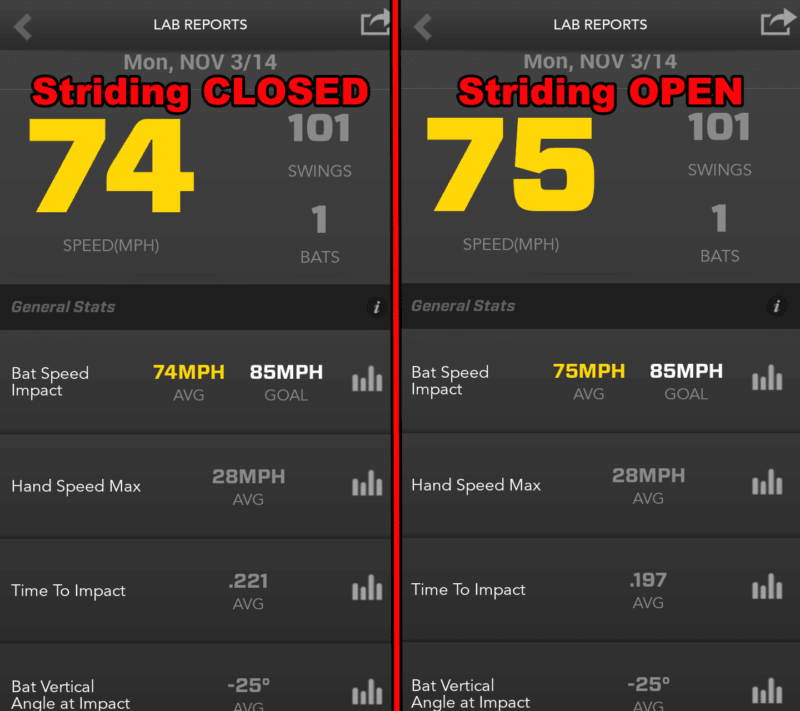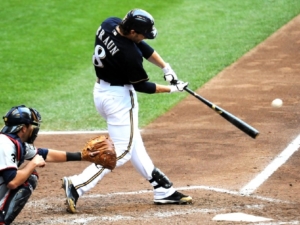Learn how to fix the lower half stride load swing technique including drills for baseball and softball players.
Alex Gordon Swing Analysis Experiment: Top Out Bat Speed By Striding Closed?
Question: Does Striding Front Leg Closed Increase OR Decrease Bat Speed?
I was taught my whole playing career to stride front foot closed. Using the Zepp (Labs) Baseball app, I wanted to use the Scientific Method to analyze whether striding with the front leg closed will have a positive or negative effect on bat speed.
Background Research
Here are a couple posts to further your understanding of spinal engine mechanics, as we move to discover what effect striding with a closed front leg will ultimately have on bat speed…
- Miguel Cabrera Reveals the Timing of Torque,
- Josh Donaldson: Stay Closed & ADD Ball Exit Speed, and
- Baseball Lessons Video: Better Mechanics, More Drive.
Also, CLICK HERE to watch this video from ZenoLink’s Chris Welch on stride principles.
SCIENCE-BASED TRAINING:
Improve your hitting strategy dramatically by applying human movement principles.
Learn not only how and what to train but also the science behind the methods.
Hypothesis
Based primarily on my research and study of Dr. Serge Gracovetsky’s book The Spinal Engine, I believe landing with an open front leg – like Alex Gordon – will result in increased bat speed and farther batted ball distance. Landing closed with the front leg – like Kansas City Royals catcher Salvador Perez (who popped out to end the 2014 World Series) – will result in an inefficiency to hitting inside and high pitches. And will allow other compensations to occur such as rolling over, pulling the head, and the front shoulder flying open.
Alex Gordon: Striding Open/Closed Experiment
Equipment Used:
- Zepp Baseball app
,
- ATEC Tuffy Batting Tee,
- Bownet,
- Rawlings Official NCAA Baseballs,
- Two yellow dimple baseballs (feedback markers),
- Flip Video Camera
and Tripod, and
- 33 inch, 30 ounce Pinnacle Bamboo bat.
Setup:
- Yellow dimple ball feedback markers = my bat length, plus two baseballs
- Distance from plate = end of the bat touching inside corner of plate, and knob of bat touching my mid-thigh
- Tee was set one baseball’s length behind the front feedback marker, and tee height was about mid-thigh
- Forward momentum was eliminated in this experiment, and I hit from a 1-2 second pause at landing
- First 100 baseballs hit I was striding with a CLOSED front leg
- Last 100 baseballs hit I was striding with an OPEN front leg
- There was about 15-30 minute break between both Alex Gordon & Salvador Perez Experiments
Data Collected (Zepp Baseball App):
Data Analysis & Conclusion
Observations from the Zepp Baseball app screen capture above:
- Striding OPEN added 1-mph of bat speed on average
- Interestingly, striding CLOSED added 0.024 “Time To Impact” on average
Not much change there…but the devil’s in the details…
- Striding CLOSED shifted bat speed downstream into the [< 69] to [70-74-mph] ranges
- Striding OPEN shifted bat speed upstream into the [75-79] to [80+ mph] ranges
- Striding CLOSED top out bat speed was 81-mph…80-mph (once) and 81-mph (twice)
- Striding OPEN top out bat speed was 83-mph…80-mph (6-times), 81-mph (3-times), 82-mph (3-times), & 83-mph (once)
Notes
- Striding open with the front leg definitely increased top out bat speed (83-mph v. 81-mph).
- There was a better chance to maintain higher bat speeds with striding open.
- During the Alex Gordon Experiment, when striding front leg open, my front foot was at a 45-70 degree angle.
- I also felt that I had an easier time accelerating the barrel down (towards catcher’s glove) when my stride leg was open, which helped keep my bat speed more consistent. I felt like I had to pull across my body (or chop down) striding with a closed front leg, which made my bat speed more erratic during the first part of the Experiment.
- I purposely eliminated forward momentum from the Experiment because I wanted to isolate how much striding closed took away from bat speed. In addition, I wanted to preserve accuracy in execution with the two different mechanical scenarios.
The Bottom Line?
Spinal engine mechanics drive all human movement, according to Dr. Serge Gracovetsky. When we do things to hinder efficient spinal engine mechanics, reciprocal inhibition takes over depressing a hitter’s ability to maintain higher bat speeds over longer periods. In addition, striding with a closed front leg will cause a hitter to be inefficient getting to inside and higher pitches. A great number of coaches teach hitters to stride with the “front foot closed”. This is the very reason the following compensations occur that these coaches waste their time trying to correct!!
- Front shoulder flying open,
- Head pulling out, and
- A shorter hand and barrel path to the ball, resulting in the
- Barrel having limited time on the plane of the pitch, which increases mis-hits and strikeouts.
This is why I think Salvador Perez had a hard time handling Madison Bumgarner. MadBum kept busting him up and in. Because Salvador Perez strides closed I believe this stunted his chances of knocking in Alex Gordon from third at the end of the game.









